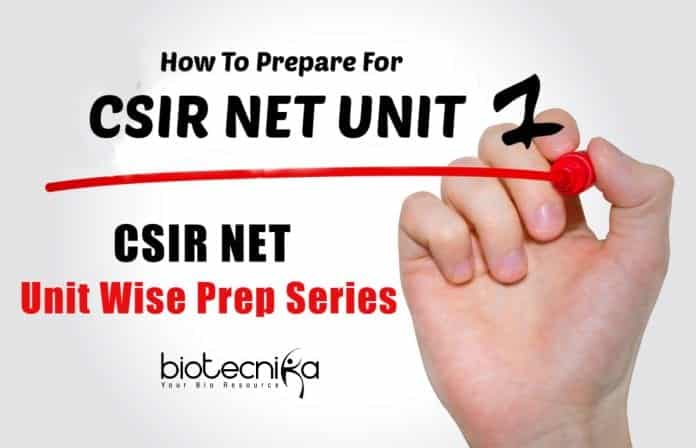CSIR Unit 1 Preparation – Best Way to Prepare for CSIR Exam UNIT 1
CSIR NET Unit Wise Prep Series – PART 1
As we all know it’s very difficult to enter the Research and Development of any institute without a qualification. Thus CSIR Net Exam plays a very important role in that. However, clearing this exam is not everyone’s cup of tea but yes if you have passionate determination towards it then undoubtedly you can enter into the world of research. Since CSIR net is around the corner and I know everyone is deliberately studying, practicing questions, discussing topics, etc. So here we go to discuss one of the most important units from our CSIR syllabus i.e. Unit 1.
You can expect a good number of questions from this particular unit both in part B and part C. I won’t say this is being the toughest unit in your syllabus but I would say one thing for sure, without this unit its difficult to clear the CSIR Exam. Because this particular unit has got connectivities to various other units from the syllabus. Like for instance, You study the basics of nucleic acids in this unit so without understanding this
particular basic how you are going to understand replication, the entire fundamental process, and without this knowledge how you are going to understand the techniques that are involved behind it. So skipping this unit is a big blunder.First, let us look at the CSIR Unit 1 Syllabus:
MOLECULES AND THEIR INTERACTION RELEVANT TO BIOLOGY
- Structure of atoms, molecules, and chemical bonds.
- Composition, structure, and function of biomolecules (carbohydrates, lipids, proteins, nucleic acids, and vitamins).
- Stabilizing interactions (Van der Waals, electrostatic, hydrogen bonding, hydrophobic interaction, etc.).
- Principles of biophysical chemistry (pH, buffer, reaction kinetics, thermodynamics, colligative properties).
- Bioenergetics, glycolysis, oxidative phosphorylation, coupled reaction, group transfer, biological energy transducers.
- Principles of catalysis, enzymes and enzyme kinetics, enzyme regulation, mechanism of enzyme catalysis, isozyme.
- Conformation of proteins (Ramachandran plot, secondary structure, domains, motif, and folds).
- Conformation of nucleic acids (helix (A, B, Z), t-RNA, micro-RNA).
- Stability of proteins and nucleic acids.
- Metabolism of carbohydrates, lipids, amino acids nucleotides, and vitamins.
In simple words, the CSIR Unit 1 Preparation involves dealing with Biochemistry as a whole. Mostly they will be asking within the range of 25-30 marks. From Part B it is 17.41% and 8% of Questions for Part C is always expected.
Coming to the reference book it will undoubtedly be the Lehninger book and try to go for the latest edition if possible. So to prepare this unit it’s wiser to use pen and paper meaning practicing rather than just mugging up. Because this unit includes structures, classifications, and a lot of pathways. You cannot just simply mug up, you need to practice it on a regular basis. Try to make your notes in the form of flowcharts for all the pathways you come across so that it will make you feel a simpler and understandable manner. Biochemistry means structures. So be it carbohydrates, amino acids, nucleic acids, or lipids study with structure.
Your CSIR Unit 1 Preparation should be in such a way that if anyone asks you what is a carbohydrate or nucleic acid or a particular amino acid then your mind should speak the language of structures, the bonds involved, the specificity of the side chains involved, etc.
1. Structure of atoms, molecules, and chemical bonds: So when it comes to the structure of atoms, molecules, and their molecular interactions you can expect some Part-B kind of questions and sometimes in Part-C too.
2. Composition, structure, and function of biomolecules (carbohydrates, lipids, proteins, nucleic acids, and vitamins):
- For biomolecules, as you all might be aware of the fact that carbohydrates are being asked on a regular basis for eg regarding its stereochemistry so here you need to understand the concept behind the terminologies like epimers, anomers, reducing and non reducing sugars with examples as well as their linkages.
- Next is protein. Structure of amino acids is also important with their significance or properties of their side chain, their classification based on charge, polar and nonpolar, positive and negative, acidic and basic, hydrophilic, and hydrophobic. Another important thing here is regarding the protein folding and the molecular chaperone which assist in it. Of course, you will be studying in detail about it in Unit-2. Then regarding protein sequencing, you will be studying in unit-13.
- Coming to nucleic acid, the structure and alternative names of nucleotides, examples of modified nucleotide, synthesis of nucleotides; topology of nucleic acids like twist, writhe, and linking no. Numerical questions from here too Hershey and chase expt, which you will study in unit-3 in detail.
- Coming to lipid you must know about the phospholipids, glycolipids, eicosanoids, etc.; beta-oxidation study related to the membrane, case studies based on melting point, chilling, and temperature-related i.e. in terms of the degree of unsaturation and saturation, length of the fatty acyl chain.
- The function of different vitamins along with their deficiencies(last time it was asked in the form of a match the following, so this time you can expect it in some other way).
3. Stabilizing interactions (Van der Waals, electrostatic, hydrogen bonding, hydrophobic interaction, etc.): Questions from stabilizing interactions also you can expect. Focus more on hydrogen bonding, ionic interactions.
CSIR NET Quick NET Revisor 2020 (QNR 2020)
4. Principles of biophysical chemistry (pH, buffer, reaction kinetics, thermodynamics, colligative properties): Regarding principles of biochemistry, here calculations are more important for eg: They will provide the pKa value of different amino acids and we need to find out their pI. Next, they may also ask calculative questions with respect to peptide bonds as well. when it comes to thermodynamics, Gibbs free energy is an important topic to be considered. Numericals are most commonly asked from thermodynamics.
5. Bioenergetics, glycolysis, oxidative phosphorylation, coupled reaction, group transfer, biological energy transducers: Coming to bioenergetics, another important topic from this unit from where you can expect questions for sure.the pathways especially glycolysis, enzyme regulation, TCA cycle, an enzyme inhibitor, steps producing ATP and NADPH, FADH, their calculation based on radioactivity, gluconeogenesis, fermentation, insulin and glucagon, aerobic and anaerobic fermentation, Cori cycle, pentose phosphate pathway significance, numerical question both in b and c. Pathways mainly you can expect in part-c. Stoichiometry of each pathway is also important.
6. Principles of catalysis, enzymes, and enzyme kinetics, enzyme regulation, mechanism of enzyme catalysis, isozymes: Michaelis – Menten equation is one such topic that is unavoidable, so be it June or be it December be prepared for it; never ever skip this topic from unit-1. Lineweaver Burk plot is another important thing followed by types of inhibitions and the graphs related and the km and Vmax value of each type of inhibition; reversible and irreversible(competitive, uncompetitive, non-competitive and mixed); specificity constant, turnover no., the specificity of enzyme, the importance of km and kcat, enzyme affinity, allosteric regulation.
7. Conformation of proteins (Ramachandran plot, secondary structure, domains, motif, and folds): Here of course Ramachandran plot is the most important topic to be considered. But surprisingly it wasn’t asked in Dec 2019 so you can expect it in the upcoming exam. You must be well versed about it i.e. regarding the values. Apart from that protein structures like primary, secondary, tertiary, quaternary then the composition of certain proteins like collagen which you will also study in unit-4. Then terminologies like domains, folds, and motifs. You need to have a check regarding the differences between hemoglobin and myoglobin especially their saturation curves; then oxygen saturation curve with respect to infant and adult, their difference in structure, then comparing the curves of higher and lower altitude people; the Bohr effect and significance of BPG. Techniques involved their sequencing.
8. Conformation of nucleic acids (helix (A, B, Z), t-RNA, micro-RNA): comparison between a.b, z DNA in terms of their properties; Then about RNA and its types along with structures(tRNA), the functional difference must also be considered.
10. Metabolism of carbohydrates, lipids, amino acids nucleotides, and vitamins: This is also one of the important topics to be considered especially carbohydrates and lipids(beta-oxidation of lipids); you can expect in Part-C.
I hope this article must have given you some relief for the preparation strategy for CSIR Unit 1 Preparation. Study well, keep on revising and keep on practicing questions more. Be confident, be positive, and of course never forget to believe in yourself.
All The Best for the upcoming exam!
Author: Divya.S – CSIR NET Expert @ Biotecnika







































This is Important Information to preparation of CSIR
Yes it was a useful and helpful article, kind of direction it has given, that’s nice.
Very useful syllabus planogram for cracking csir net exam thank you biotechnika group
Thank you so much for this detailed note on important topics
Useful tips
Thanks Biotechnika group for helping financially weak Children and your group would be known worldwide one day…..
THIS IS USEFUL.THANK YOU
9th subtopic – Stability of proteins and nucleic acids – MISSING